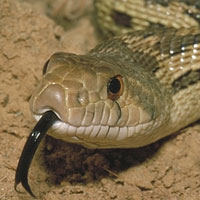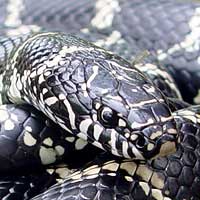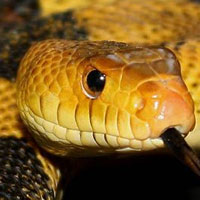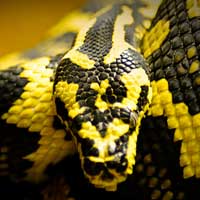Everything You Need to Know About the Reticulated Python
The scientific name of the Reticulated Python is Malayopython reticulatus, and it belongs to the Pythonidae family, which consists of non-venomous constricting snakes commonly referred to as pythons.
Scientific Name: Malayopython reticulatus
Snake Family: Pythonidae
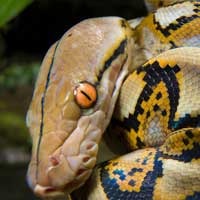
Introduction to the Reticulated Python
The Reticulated Python (Malayopython reticulatus) is the longest snake in the world and one of the most visually stunning species due to its intricate geometric patterns. Native to Southeast Asia, this non-venomous constrictor is both admired and respected for its size, strength, and beauty. In captivity, it requires an experienced handler who understands its unique needs. This guide explores the Reticulated Python’s natural habitat, diet, behavior, and care requirements, providing valuable insights for enthusiasts and keepers alike.
Exploring the Natural Habitat of the Reticulated Python
The Reticulated Python thrives in the tropical rainforests and wetlands of Southeast Asia. Its natural environment provides the warmth and humidity crucial to its survival.
- Geographic Range: Found in Indonesia, Malaysia, Thailand, the Philippines, and surrounding areas.
- Preferred Habitat: Rainforests, swamps, rivers, and mangroves.
- Climate: Warm and humid with temperatures ranging between 78°F and 90°F.
| Region | Habitat Type | Key Features |
|---|---|---|
| Indonesia | Rainforests | High humidity, dense foliage |
| Thailand | Rivers and Swamps | Ample prey, aquatic access |
| Philippines | Mangroves | Wet conditions, abundant shelter |
Diet and Feeding Habits of the Reticulated Python
The Reticulated Python is a carnivorous predator with a varied diet that reflects its opportunistic feeding behavior. In captivity, meeting its dietary needs requires careful planning.
- Natural Diet: Mammals, birds, and occasionally reptiles.
- Feeding Frequency:
- Juveniles: Every 5-7 days to support growth.
- Adults: Every 10-14 days depending on size and activity level.
- Captive Feeding Tips:
- Offer pre-killed, thawed rodents or rabbits to ensure safety.
- Feed in the evening to mimic natural hunting behavior.
- Monitor feeding habits to prevent overfeeding and obesity.
Behavior and Temperament of the Reticulated Python
The Reticulated Python is known for its curious and active nature. While generally docile in captivity, its size and strength require respect and careful handling.
- Activity Patterns: Nocturnal, with hunting and movement occurring primarily at night.
- Defensive Behavior: May strike if threatened but typically calms with regular handling.
- Interaction with Humans: Requires experienced handling due to its size and power.
Building trust through consistent interaction and respecting their boundaries ensures a positive relationship with your Reticulated Python.
Health and Lifespan of the Reticulated Python
The Reticulated Python can live 20-30 years in captivity with proper care. Regular health monitoring and maintaining an optimal environment are key to its longevity.
- Common Health Issues:
- Respiratory infections from low humidity or improper temperatures.
- Shedding problems due to insufficient humidity.
- Parasite infestations such as mites or ticks.
- Preventive Measures:
- Maintain humidity levels between 60-80%.
- Provide a temperature gradient with basking spots at 88°F-92°F.
- Ensure routine health checks and a clean enclosure.
Reproduction and Breeding of the Reticulated Python
The Reticulated Python is oviparous, laying eggs during the breeding season. Successful breeding in captivity requires careful environmental control and monitoring.
- Mating Season: Typically occurs during cooler months.
- Clutch Size: 20-80 eggs per clutch.
- Incubation Period: 80-90 days at temperatures of 88°F-90°F.
- Breeding Tips:
- Simulate seasonal temperature changes to trigger breeding behavior.
- Provide a nesting box with suitable substrate for egg-laying.
- Monitor incubation conditions to ensure successful hatching.
Handling and Caring for a Reticulated Python
Handling and caring for a Reticulated Python requires experience and commitment. With proper care, these snakes can thrive and become rewarding companions.
- Enclosure Requirements:
- Minimum size: 10’ x 5’ x 5’ for adults.
- Include climbing branches, secure hides, and a large water dish for soaking.
- Maintain proper lighting and temperature gradients.
- Handling Tips:
- Handle gently and support the snake’s entire body.
- Avoid handling during shedding or immediately after feeding.
- Always have an experienced handler or assistant when managing large specimens.
By understanding their unique needs, Reticulated Pythons can provide years of fascination and enjoyment for dedicated keepers.
Other Snakes In This Species
 Amethystine Python
Amethystine Python Ball Python
Ball Python Black-Headed Python
Black-Headed Python Boelens Python
Boelens Python Borneo Blood Python
Borneo Blood Python Burmese Python
Burmese Python Burrowing Python
Burrowing Python Centralian Python
Centralian Python Childrens Python
Childrens Python Coastal Carpet Python
Coastal Carpet Python Diamond Python
Diamond Python Green Tree Python
Green Tree Python Indian Python
Indian Python Inland Carpet Python
Inland Carpet Python Jungle Carpet Python
Jungle Carpet Python Macklots Python
Macklots Python Malaysian Blood Python
Malaysian Blood Python Olive Python
Olive Python Pygmy Python
Pygmy Python Reticulated Python
Reticulated Python Ringed Python
Ringed Python Rock Python
Rock Python Rough Scaled Python
Rough Scaled Python Spotted Python
Spotted Python Sumatran Blood Python
Sumatran Blood Python Timor Python
Timor Python White Lipped Python
White Lipped Python



